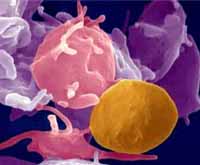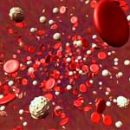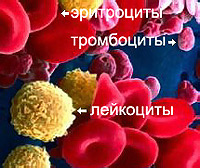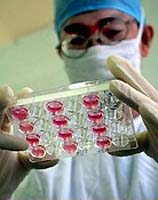Platelets are red blood records that are formed from the giant cells of the red bone marrow of megakaryocytes. Increased platelet levels in the blood obtained the name of thrombocytosis.
Content
The role of platelets in the body
 Platelets, or blood records, are formed from giant red bone marrow cells - megakaryocytes. In the bloodstream, platelets have a round or slightly oval shape, the diameter does not exceed 2-3 microns.
Platelets, or blood records, are formed from giant red bone marrow cells - megakaryocytes. In the bloodstream, platelets have a round or slightly oval shape, the diameter does not exceed 2-3 microns.
Normally, the number of platelets in a healthy person is 200-400 thousand. in 1 μl. The increase in the number of platelets is called «Thrombocytosis». In natural conditions, the number of platelets is subject to significant fluctuations (their number increases with painful irritation, physical exertion, stress), but rarely goes beyond the norm.
The main purpose of platelets is to participate in the process of hemostasis - stop bleeding. An important role in this reaction belongs to the so-called platelet factors, which are focused mainly in platelet granules and membrane.
Platelets take part in the protection of the body from alien agents. They possess phagocytic activity, contain immunoglobulins that distinguish substances that can destroy the membrane of some bacteria. In addition, peptide factors causing transformation were found in their composition «Zero» lymphocytes (0 lymphocytes) in T- and B-lymphocytes. These compounds in the process of activation of platelets are highlighted in the blood and during the injury of vessels protect the body from entering pathogens of microorganisms.
Thrombocytopower regulators (processing process in the red bone marrow) are thrombocytopoethines of short-term and long-term action. They are formed in the bone marrow, spleen, liver, and also part of megacarocytes and platelets. The activity of thrombocytopoietins is directly influenced by IL-6 and IL-11.
Concept of thrombocytosis
After the emergence of automata to count the blood formula, the calculation of platelets has become an inseparable part of blood testing. Thrombocytosis (defined as the number of platelets of more than 500 g / l, despite the fact that the normal values of the number of platelets are within 150-400 g / l) is detected by randomly or under system examination (before surgery). It turns out that from 3 to 13% of people who have a blood study in the hospital, the number of platelets exceeds 500 g / l, that is, we are talking about a relatively frequent anomaly in the practice of a doctor.
The causes of thrombocytosis are numerous, but most often we are talking about secondary thrombocytosis or reactive and extremely rarely about primary. In the first case, the amount of platelets is usually less increased (from 500 to 700 g / l), but the number of platelets is not specific to the diagnosis.
The role of megakaryocytes - platelet predecessors
Megacariocytes - Giant bone marrow cells from which platelets are subsequently formed. The megacariocyte is distinguished by large sizes (the diameter of this cell is 35-160 microns) and is incorrect, divided into a plurality of the kernel; contained in it a large number of cytoplasm. Platelets, like megacariocytes, have on their surface receptors to thrombopoetin. Thrombopoietin is a hormone, regulating division, ripening and output to blood platelets. It is synthesized in the liver and kidneys. Drombopoietin's hepatic synthesis can be stimulated by the release of substances - interleukins, which are activated in the case of inflammatory syndrome or tumor pathology.
With primary thrombocytosis, the level of thrombopoietin is increased or normal and may have anomalies in platelet ripening processes. In secondary thrombocytosis, the level of thrombopoietin varies depending on the cause of the disease.









